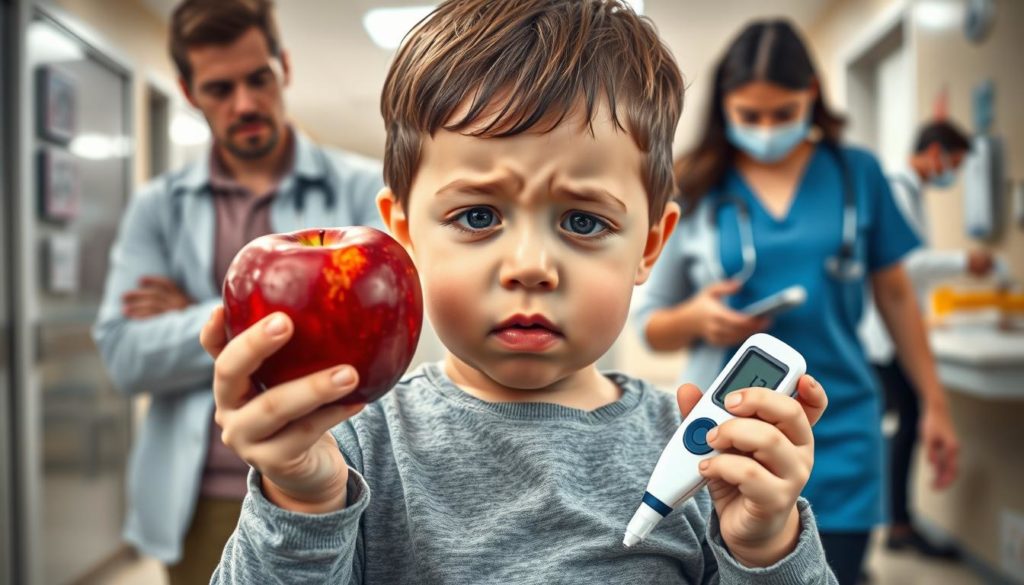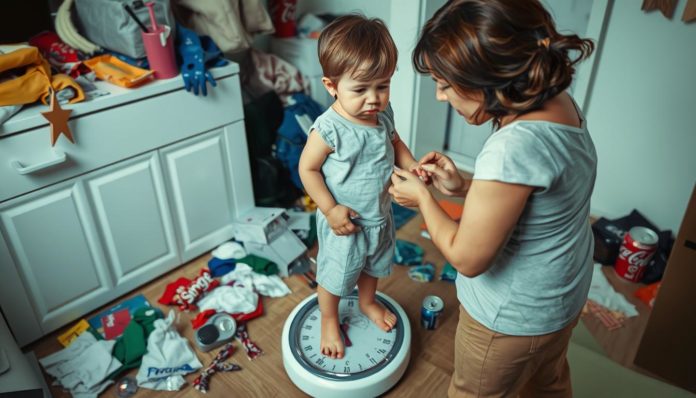Nearly 1.25 million Americans have Type 1 diabetes, and many are kids. This type, once called juvenile diabetes, is serious. The body of a child with it stops making insulin. This leads to health issues needing constant care.
Spotting early signs of Type 1 Diabetes in kids is tough because it happens fast. Look for increased thirst, more bathroom visits, lots of hunger, weight loss without trying, tiredness, and being easily upset. It’s vital to notice these hints early. This means you can get your child help quickly, keeping them healthy.
Understanding Type 1 Diabetes in Children
Type 1 diabetes is a chronic condition where kids’ pancreases stop making insulin. Insulin is crucial for managing sugar in the body. This condition, caused by genes and environmental factors, presents big health problems.

What is Type 1 Diabetes?
Type 1 diabetes happens when the body’s immune system attacks insulin-making cells in the pancreas. This means sugar builds up in the blood. Spotting Type 1 Diabetes symptoms in kids early, like being very thirsty or going to the bathroom a lot, is key for handling it well.
How Type 1 Diabetes Affects Children
Signs of diabetes in children can impact several major body parts. If not treated, it can harm the heart, kidneys, nerves, and eyes. Factors like genetics and certain viruses may raise a child’s risk of getting it. Knowing and catching Type 1 Diabetes symptoms in kids early can prevent serious health issues.
Common Symptoms of Type 1 Diabetes in Children
Spotting Type 1 diabetes in kids early is key for timely treatment. Let’s look at the main signs that parents need to watch out for.
Increased Thirst and Frequent Urination
Kids with Type 1 Diabetes may drink more and pee a lot. This is because the blood has too much glucose. The kidneys then have to work harder to deal with it.
Extreme Hunger and Unintentional Weight Loss
Extreme hunger along with losing weight without trying is another sign. This happens because the body’s cells can’t get sugar due to a lack of insulin. So, the body feels very hungry, and kids might lose weight.
Fatigue and Irritability
Feeling very tired and easily upset are common signs too. Without insulin, sugar can’t get into the cells for energy. This makes kids feel tired and cranky.

It’s important for parents to keep an eye out for these diabetes symptoms. Early action can really help in managing the disease.
| Symptom | Description |
|---|---|
| Increased Thirst & Frequent Urination | Excess glucose in blood leads to increased thirst and urination |
| Extreme Hunger & Weight Loss | Body’s inability to utilize sugar causes intense hunger and weight loss |
| Fatigue & Irritability | Low energy levels due to insufficient glucose entering the cells |
Signs of Type 1 Diabetes in Children
Spotting signs of diabetes in toddlers early is very important. It means you can start treating it right away. Looking for these symptoms will show you if medical help is needed. Here are the main things to watch out for:
Bed-Wetting in Toilet-Trained Children
Unexpected bed-wetting in kids who use the toilet can signal diabetes. It’s because their body tries to get rid of extra sugar through urine. This can worry parents a lot, making a doctor’s visit necessary.
Fruity-Smelling Breath
If a child’s breath smells fruity, it may point to diabetes. This happens when the body uses fats for energy, not sugar. This smell comes from something called ketones and means you should see a doctor.
Blurred Vision
Too much sugar in the blood can blur a child’s vision. This happens when sugar makes the eye’s lens swell, affecting how clear they see. If your child can’t see well, it’s time to get help.
Risk Factors for Type 1 Diabetes
It’s important to know the risk factors for Type 1 diabetes. This helps us spot symptoms in children early. Factors like genetics and the environment can lead to diabetes in kids.
Genetic Factors
Genetics is a big risk factor for Type 1 Diabetes. Kids with Type 1 diabetes in their family are more likely to get it. Being prone to the disease can come from certain genes, like HLA genes. Also, white non-Hispanic children in the U.S. are more at risk.
Environmental Triggers
Environment matters too in causing Type 1 diabetes. Viral infections might start an autoimmune attack on cells that make insulin in the pancreas. Low Vitamin D and early cow’s milk can also be risks. Knowing these can help us understand and maybe prevent diabetes in kids.
| Risk Factor | Details |
|---|---|
| Genetic Factors | Family history, genetic markers like HLA genes, higher incidence in white non-Hispanic children |
| Environmental Triggers | Viral infections, low Vitamin D levels, early cow’s milk introduction |
Why Early Diagnosis is Critical
Knowing the early indicators of Type 1 Diabetes in kids is key for quick action. Spotting these signs early means children get help sooner, avoiding worse problems. Pediatric Type 1 Diabetes spotted early can really improve a child’s life.
With early detection, managing Type 1 Diabetes is about timely insulin and healthy lifestyle changes. Without early diagnosis, children could face very serious issues. These include diabetic ketoacidosis and damage to the heart and other organs.
Spotting diabetes early lets doctors set up a careful plan for blood sugar control. This helps avoid big problems later on. Acting early not just helps kids live longer. It also improves their life quality by stopping the bad effects of unmanaged diabetes.
How to Monitor Blood Sugar Levels
Effectively monitoring childhood diabetes is key in managing Type 1 diabetes in kids. Parents and healthcare providers can better plan meals, physical activities, and medications by closely watching blood sugar levels.
Blood Glucose Testing Methods
Traditional blood glucose testing requires daily finger pricks to check sugar levels. While this method works, it can be bothersome for children. Thus, sticking to a regular testing schedule is crucial for accurate results and effective blood sugar management.
Continuous Glucose Monitors
Continuous glucose monitors (CGMs) are cutting-edge tools that give instant glucose readings. They use a tiny sensor beneath the skin to track sugar levels constantly. CGMs reduce the need for many finger pricks and provide a detailed blood sugar trend over time.
Using CGMs to monitor childhood diabetes significantly improves glucose management. It brings comfort and a higher life quality for kids and their families.
Here’s a simple comparison of traditional blood glucose testing and continuous glucose monitors:
| Method | Pros | Cons |
|---|---|---|
| Blood Glucose Testing | Accurate readings; widely available | Frequent finger pricks; time-consuming |
| Continuous Glucose Monitors | Real-time data; less intrusive | Higher cost; requires calibration |
Treatment Options for Type 1 Diabetes in Children
It’s key to know the latest in *Type 1 Diabetes treatment in children* for better management. Here are the top treatment choices available.
Insulin Therapy: Injections and Pumps
Type 1 Diabetes treatment in children mainly uses insulin therapy. Kids can get insulin through shots or an insulin pump. The choice depends on the child’s daily life, health needs, and what they like best.
Diet and Exercise Management
Diet and exercise are important when managing pediatric diabetes with insulin. A well-thought-out diet controls carbs and supports general health. Working out regularly balances blood sugar and boosts heart health and fitness.
Let’s compare the two key ways to manage insulin for pediatric diabetes:
| Insulin Management Method | Advantages | Considerations |
|---|---|---|
| Multiple Daily Injections | – Flexible dosing – Less expensive | – Needs many injections daily – Constant check on blood sugar |
| Insulin Pumps | – Steady insulin delivery – Finer blood sugar control | – Pricier – Needs looking after the device |
Potential Complications if Left Untreated
Children with untreated Type 1 Diabetes face serious risks. They could quickly encounter severe health issues. Diabetic ketoacidosis (DKA) is a key danger, where blood becomes highly acidic.
This condition requires urgent medical help to avoid critical outcomes. It’s critical to act fast in such situations.
Ketoacidosis and Ketone Testing
DKA is a severe problem in kids with unmanaged Type 1 diabetes. Testing for ketones often can catch DKA early. If your child has symptoms like fruity breath or feels very tired, see a doctor right away.
The Mayo Clinic warns that not treating Type 1 diabetes can lead to serious health issues.
Long-term Health Risks
If Type 1 Diabetes is not managed well, it can hurt the body over time. It can cause heart problems, potential heart attacks, or strokes. Kidney damage might lead to needing dialysis, and nerve damage can result in neuropathy.
Eye problems are also common, and poor glucose control can even cause blindness. Keeping blood sugar under control and regular doctor visits can lessen these risks. This gives kids a better chance at a healthy life.
For tips on managing Childhood diabetes complications, check the Mayo Clinic site.
The Role of Healthcare Providers
Healthcare providers play a key role in helping families navigate Type 1 diabetes in kids. They perform regular check-ups important for managing sugar levels, monitoring growth, and spotting early complications. This ensures each child gets care that fits their specific needs.
Regular Medical Check-Ups
Regular appointments help manage child diabetes care. They allow adjustments to insulin and diet plans. Specialists work with families to maintain the health of their children.
Support Services for Families
Support extends beyond just medical help. It includes educational and emotional support services. With diabetes camps, support groups, and counseling, a support network is formed. This helps children with Type 1 diabetes lead a balanced, healthy life.
FAQ
What are the early signs of Type 1 Diabetes in children?
Early signs in children include increased thirst and frequent urination. Kids may feel very hungry, lose weight without trying, and feel tired often. They might also show irritability, mood swings, and their breath might smell fruity.
What is Type 1 Diabetes?
It’s when a child’s body attacks cells in the pancreas, stopping insulin production. This leads to high blood sugar levels. Kids then need insulin from outside sources to stay healthy.
How does Type 1 Diabetes affect children?
It causes sugar to pile up in the blood. This can harm the heart, kidneys, eyes, and nerves if it’s not kept in check.
What are common symptoms of Type 1 Diabetes in kids?
Kids may get very thirsty, go to the bathroom a lot, and feel hungrier than usual. They might lose weight suddenly, feel weak, and get easily annoyed. Some might have breath that smells sweet and see things as blurry.
What signs of diabetes should I look for in toddlers?
Look for signs like bed-wetting, even if they’re already toilet trained. They might drink more, pee a lot, feel very hungry, lose weight, and show changes in how they act.
How do genetic factors influence the risk of Type 1 Diabetes in children?
Certain genes can make kids more likely to get Type 1 Diabetes. If diabetes runs in the family, the risk goes up for the child.
What role do environmental triggers play in Type 1 Diabetes?
Things in the environment, like some viruses, might start the body’s attack on the pancreas. This can lead to Type 1 Diabetes.
Why is early diagnosis of Type 1 Diabetes in children critical?
Finding it early helps avoid very serious problems like diabetic ketoacidosis and heart disease. Getting treatment early means the child can live a healthier life.
What methods are used to monitor blood sugar levels in children with Type 1 Diabetes?
Kids can check their sugar by poking their finger or using a CGM. CGMs give sugar levels in real-time, helping manage diabetes better.
What treatment options are available for Type 1 Diabetes in children?
Kids need insulin, which they can get through shots or a pump. Eating right and staying active are also key to controlling their sugar levels.
What are the potential complications if Type 1 Diabetes in children is left untreated?
Without treatment, kids can face diabetic ketoacidosis, heart problems, kidney failure, and issues with their vision and nerves. It’s important to treat it early and carefully.
How do healthcare providers support children with Type 1 Diabetes?
Providers help kids through regular check-ups and by keeping an eye on their sugar. They offer support, teach families how to manage the disease, and help kids live well with diabetes.


